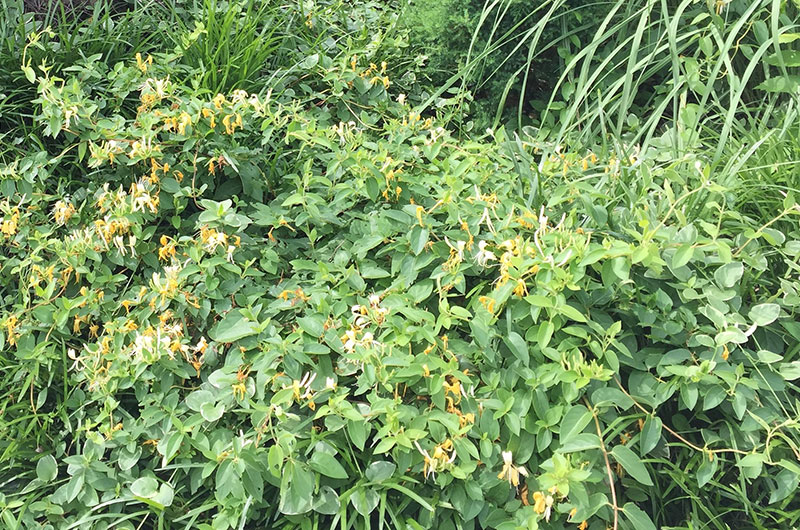by Dr. Sarah Treanor Bois
Director of Research & Education at the Linda Loring Nature Foundation
If you have read this column before, you know that I have a love-hate relationship with invasive plant species. I love to research and write about them and I hate to manage them. They are a conservationist’s nightmare.
Just a reminder that not all non-natives are an issue. The Nantucket Invasive Plant Species Committee defines an “invasive” as a non-native species that causes some kind of harm: human health, economic, or biological (usually a threat to biodiversity). It’s this last point, the harm part of the definition, which is sometimes sticky. I often get asked about beautiful invasive wildflowers, purple loosestrife for example, and am asked, “What possible harm could these pretty flowers cause?” A discussion generally follows about monocultures and the displacement of native species.
A more difficult argument to make is when a plant only fits the other part of the invasive definition; it may cause harm, but it’s actually a native species. Many of the plants that fall into this category are our native lianas. Lianas are woody vines that are rooted in the ground and use trees or other taller vegetation as a means of vertical support to reach the upper canopy. On Nantucket these include native grapes, Virginia creeper, greenbriers, and poison ivy, among others.
Lianas are often seen climbing, smothering, and sometimes girdling their host trees. The competition for light can be fierce and the one to the top gets the most light and, thus, a competitive advantage.
Being a liana is actually a very smart plant strategy. They can conserve resources that other plants allocate to structural development and devote those resources instead to growth and reproduction. Even Charles Darwin marveled at this strategy in his explorations of the Galapagos and other expeditions. The liana growth form is found in many plant families indicating that this climbing habit has evolved multiple times. There is, thus, a great diversity of liana species around the world. In North America, however, they are much less prevalent.
We actually have relatively few liana species in our flora; not just on Nantucket, but in North America in general. That is one hypothesis as to why many species that have become invasive in the United States are lianas from other parts of the world, namely southeast Asia and South America. Chocolate vine, Japanese honeysuckle, Oriental bittersweet, porcelain berry, and the infamous Kudzu vine are just a few representatives that are invasive on the Atlantic coast. These plants tend to occupy edge habitat, which is increasing with forest fragmentation.
It’s not all bad, though. Lianas provide habitats for many birds and other creatures. These woody vines are more common in tropical forest where they are favorite homes for monkeys, lemurs, and sloths where they provide shelter, food, and higher mobility. Some lianas can even support trees during strong winds. I wonder if we’ll ever see a monkey in Nantucket’s bountiful poison ivy along the edge of the State Forest.
Poison ivy is the native liana that I am most often asked about. There are, of course, obvious human health effects with this one. Many people, 85% in fact, are allergic to the oil urushiol produced by the poison ivy plant. As much as I generally dislike poison ivy, it is a native species and has redeeming ecological qualities.
Only humans are allergic: other animals are immune to poison ivy. Fruits are plentiful from now through fall and are a boon to migratory birds beginning their journey as well as for other wildlife.
Native greenbrier and cat brier can produce a thicket of thorny vines, a menace to any garden bed. This same thicket can provide protection for small mammals from larger predators.
Unlike some invasive vines, native species have evolved to be part of the environment of Nantucket. As such, they are part of the biological community benefiting from some species and being consumed by others.
For greenbrier, the leaves are consumed by deer and other herbivores. The fruits are a good source of food during the winter, and the nectar from the greenbrier flowers is even consumed by invertebrates like butterflies. Contrast that with some non-native species which may produce edible fruit, but have toxic foliage.
When pants are brought into a new geographic area, they often escape their herbivores and pathogens that kept them in check in their home range. So while our native vines can sometimes cause annoyances, their overall contributions to the ecosystem as a native species make them an essential part of Nantucket biodiversity.
However you feel about lianas, native or otherwise, be prepared for more. Recent research has shown that lianas of many species are responding to the elevated carbon dioxide levels that we’re seeing with global climate change. Some lianas can grow more abundantly and in new areas as temperatures warm. Poison ivy has been shown to grow bigger and produce more urushiol with increased carbon dioxide. Keep this in mind as we enjoy some of the only fall foliage Nantucket has to offer when poison ivy and Virginia creeper turn scarlet-red this fall.



